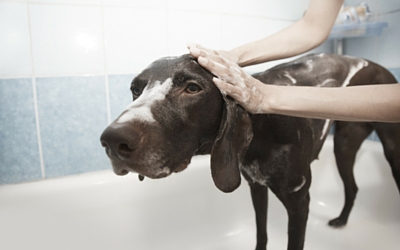
With summer comes long days spent outside, enjoying the nice weather and all the activities it has to offer. Of course, with that comes dirty dogs! Dogs often have different ideas about what counts as “dirty”, so you may need to persuade your dog that if he wants to snuggle up in bed with you that night, getting rid of that layer of grime and “doggie smell” is a must. If your pup can frequently be found crashing through the underbrush, leaping into the lake or rolling around in a questionable pile at the park, here are a few tips on how to cultivate a good hygiene routine for your dog that will make both of you much happier this summer.
Start them early!
The key to getting your dog used to bathing and grooming practices is to start when they are puppies, much like training or socialization. If you start when they are young, they learn that baths, brushing their coats, teeth, and trimming their nails are all routine happenings that they will grow to accept, even if they don’t particularly like them.
Get them used to being handled by you
Acclimate your dog to being handled by you, especially with the parts of their bodies most dogs shy away from being touched, such as paws and mouths. A few times throughout the course of the day, hold your dog and gently, but firmly, rub your hands along their back and down their legs. Then rub their tummy, paws, ears and feet. If they resist or cries out, stop but don’t let them go. Speak to them calmly until they stop protesting, then continue with the gentle massage.
Brush regularly
Every dog benefits from a regular brushing. It will remove loose hair and dead skin cells, as well as any dirt and debris that may build up, while distributing their natural skin oils along the hair shafts. How often you need to brush your dog will depend on their breed and coat type; short hair coats require less frequent brushing while longer or curly coats can benefit from a daily brushing, as will dogs that shed a lot. Regularly brushing your dog will get them used to the action, as well as help to maintain cleanliness by removing loose debris and counteracting build-up. Always brush out long or curly coats before bathing.
Use warm water and special doggie shampoos
No one likes a cold shower, especially not dogs! Be sure to use warm water when bathing your dog- bathing should be a relaxing experience for them. As a pup, newborns like being licked by their mothers to be cleaned, so the water you use should be as warm as body temperature, much like a mother’s saliva and tongue would be when grooming her puppies. Dogs typically don’t like showers, so be gentle with your use of water when bathing your dog; don’t splash, and avoid getting water in their eyes and ears. Use a washcloth to gently wash their faces, instead of pouring water over their heads. Always use a shampoo formulated for dogs, as their skin and hair needs are different than humans. There are many choices available at your local pet store or vet’s office. Ask your vet or groomer if you are unsure what types might work best for your pup’s specific needs.
Take it slowly
Hair dryers and clippers can be scary things! Introduce your pup slowly to these sometimes terrifying appliances; set them out and let them thoroughly investigate them. Then turn them on low, and again, let your pup check them out. When they seem to be more comfortable around them, then proceed to dry their hair or clip their hair or nails. If you and your pup are still not comfortable grooming on your own, take your dog to a professional groomer who will make the process easier and more relaxing for everyone.
Practice, practice, practice
Along with starting them early, being consistent with grooming practices will help you to improve your grooming skills, as well as allow your pup to become increasingly accepting of these practices. Try to create a bathing schedule for your dog, depending on their breed and requirements. If you are unsure how often you should bathe your dog, ask your vet if you aren’t going on smell alone!
You can also create a predictable cause-and-effect bathing schedule for your dog, so they understand that after certain events, a bath is likely to follow; such as a weekend at the cottage swimming in the lake means a good brushing and bath upon returning home. Creating a predictable grooming routine for your pup will help to increase their acceptance of it, no matter how grudgingly. Incorporating these easy tips into your pet’s grooming and hygiene routine will help to ensure you both have a happy and healthy summer!
